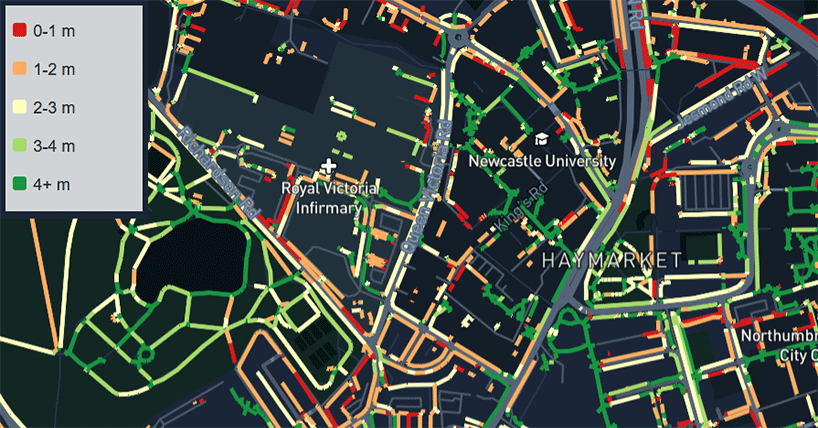Path widths
Reduction in social distancing guidance opens up cities to pedestrians
Published on: 26 August 2020
The change in social distancing rules to one metre plus has made towns and cities in England on average over 40% more accessible to pedestrians, new research has revealed.
In response to the COVID-19 pandemic, the government issued statutory guidance for local authorities to urgently reallocate road space for safe walking and cycling, acknowledging that current pavement provision is often insufficient.
Research by Newcastle University has shown that when the social distancing rule was at two metres, up to 60% of pavements in some cities were unsuitable as they were too narrow for pedestrians to keep sufficiently apart.
But now, with one metre plus in place, areas in England are on average 43% more accessible for people to stay away from one another and maintain the government’s important social distancing rule.
For example, only 11% of Newcastle’s pavements are now unsuitable at one metre in comparison to 55% at two metres; just 12% of York is unsafe as opposed to 63%; and only 10% of Birmingham is in a narrow zone rather than 51%.

Narrow pavements
The findings also highlight where pavements are inadequate and, with local authorities’ long-term plans to switch towards more journeys being taken on foot, where road space reallocation may be required.
Dr Alistair Ford, Lecturer in Geospatial Data Analytics at Newcastle University, who led the research, said: “It was surprising to see how much of our UK cities aren’t particularly friendly for people getting around on foot.
“Often we see very wide roads with lots of space for cars and then very narrow pavements either side, meaning pedestrians are unable to keep a width of two metres apart. Many of these narrow pavements are in residential areas where people are walking to shops or school.
“In city centre locations there’s a tendency for wider pavements, and these areas are also where we would typically expect to see higher footfall. This space, however, may not always be available to pedestrians and so even wider pavements don’t always indicate that adequate safe space is available.
“Reducing the distance to one metre opens up a lot more of our country’s pavements to safe walking distances. And while this is good in response to COVID-19, the reallocation of road space to pedestrians presents an opportunity to transform our urban spaces for the better in the longer-term.”
Since the new guidance was introduced, cities are more social-distance friendly as Liverpool has 91% of its pavements at a width of one metre or more, rather than just 56% at two metres or more. Meanwhile, Sheffield’s pavements are 88% compatible to the one metre or more rule, compared to just 42% at two metres or more.

Calculating widths
Experts used Ordnance Survey mapping data to calculate the width of the pavements and footpaths. This was averaged along short segments to account for variations due to parking laybys, bus stops and permanent planters.
Calculations made by Research Associate Dr Craig Robson gave the average width over each section of road or street to flag up areas where pavements may be too narrow to maintain safe social distancing and may need to be avoided or work done to widen them.
Averages were made for pavement widths across residential neighbourhoods to identify areas where priority should be given to improving walking conditions, such as in housing estates with many narrow footpaths.
The analysis, undertaken as part of the ITRC MISTRAL project, could be used by any UK local authority to help quickly identify at-risk areas and plan their government mandated road space reallocation accordingly.



